I can't sleep, so I am writing. The cold that turned me into a
Zombie Professor (see here) has somewhat predictably moved to my chest and I now have a hacking cough. Whilst I'm suffering, it does provide W
with an opportunity to practice the Black Art of dispensing over the counter
medicine. Like many other people W has great faith in those medicines we can
buy without prescription. It's paracetamol for headaches; Buttercup syrup for
coughs and Sudocrem for everything else. For children, the cure all is Capol
(in my day it was Phenergan – absolutely not recommended these days). W is not
alone in having faith in these preparations. In 2013, the UK public brought
some 942 million items of over the counter medicines to treat themselves, and
in 2014, these purchases created a £2.5 billion market.
The highest value products were
pain relief (£581 million), cough medicine (£452 million) and skin treatments
(£435 million). Medical evidence suggest that none of these medicines actually
do much good and they certainly won’t cure any of the common illnesses at all. Such
illnesses (cough and colds) account for some 57 million GP consultations a year. However with colds lasting on average
10 days and coughs up to 18 days, making most of feel miserable it is not
surprising that many of us look for some kind of relief. W, (who worked as
NHS manager for most of her working life) might have it right from an economic
perspective. Whilst it might cost us £3-4 to self-care it costs about £32 for each
visit to our GPs surgery and it costs £111
for every person who steps into A&E seeking help.
That is of course unless you live
in Chorley. Up until recently, Chorley did have their own A&E department. Not any more. The CEO of Lancashire Teaching NHS FT, Karen Partington has downgraded
the A&E department at Chorley. Claiming that they couldn’t recruit enough appropriately
trained doctors she felt it was the right, (and in NHS CEO, Simon Steven's view), a brave decision to take.
For those needing the services of A&E they are now having to travel to other
centres. Putting real pressure on these services. Whilst claiming the downgrading
is temporary, it’s not hard to imagine why Karen might want the decision to be
a permanent one. In 2015/16 year only 8 NHS FT hit the 95% A&E target, and
only one of these was in the North West – and it wasn’t Lancashire Teaching –
but many congratulations to Wrightington, Wigan and Leigh NHS FT, who were in the
top 8!
Of course you might expect me to
be great believer in self-help approaches to maintaining good health and wellbeing,
and I am. There are of course times when we can’t help ourselves, when what we
face is beyond our ability to cope. When I undertook my nurse education and training
I quickly grew to understand the fine line between being there for someone to
help them when they were unable to help themselves, and yet work towards
helping people to help themselves. Throughout
my practitioner and managerial experience it’s been a real privilege to be able
to stand beside others and be there for them when needed.
So it was brilliant to read of Henry
Heimlich’s experience last week. During my nurse training one of the things we
were taught was the Heimlich Manoeuvre – something that when used appropriately
can save someone from choking to death. In the UK some 200 people a year die
from choking on food they are eating. Well Henry, now aged 96 and living in a
residential setting, saved the life of a Patty Ris (aged 87) who started
choking on a piece of hamburger. Henry applied his manoeuver and rescued the situation.
Amazingly, it was the first time he had ever used the intervention he was most
famous for!
And last week I found I was
famous (well at least for another Andy Warhol 15 minutes of fame). Finally, I
got to launch the Industry Collaboration Zone (ICZ) programme, our University
No 1 strategic priority. It was a soft launch, only to University colleagues at
present. There was a video of course. Thankfully it was recorded before the Zombie
Professor cold and subsequent cough kicked in. I'm hoping that one of my very
clever colleagues will find a way of up-loading to YouTube so the whole world
can share. Its worth a watch!
Later on this morning my eldest daughter and
husband Stewart will be arriving here at the House in Scotland for a week’s
holiday. The twins will be 3 tomorrow and along with their older sister, Evie,
we are looking forward to celebrating big time. If, heaven forbid, any of the children
go down with an ailment, I can rest assured that W will have a remedy in the
depths of her black bag….























